Electronic vs Acoustic Drums – The Real Differences
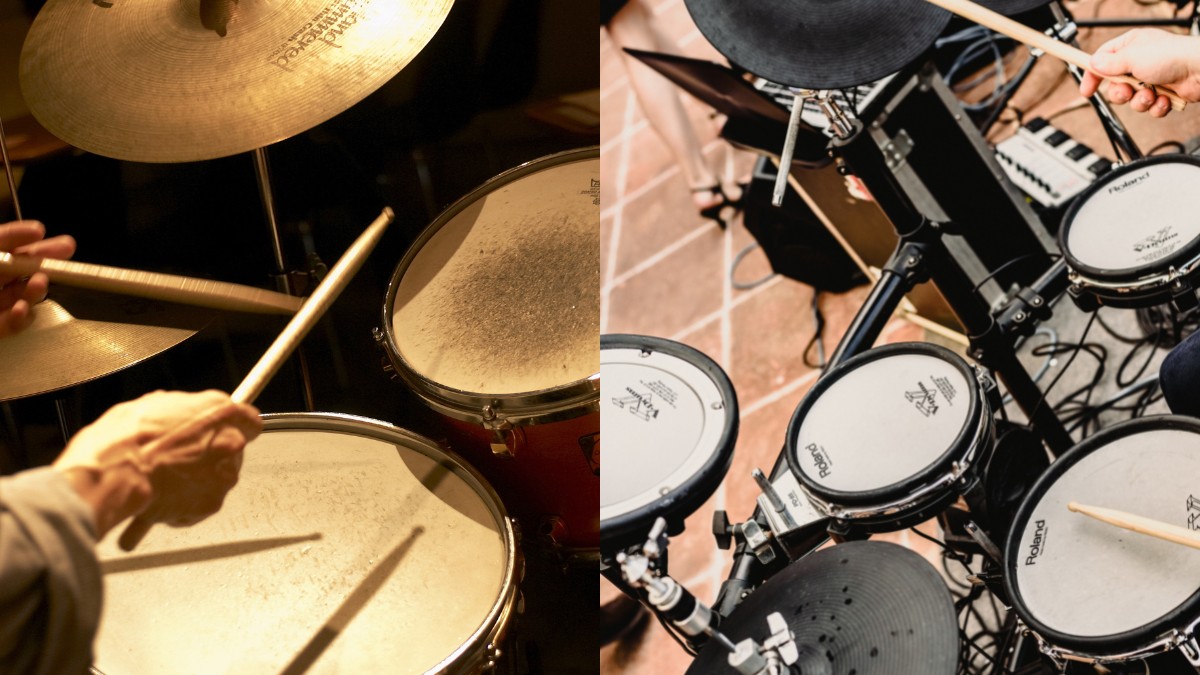
Picking between an acoustic and electronic drum set can be difficult, but the advice in this article should make it a lot easier. I play both acoustic and electronic drums, and I love both of them, so I can give a pretty balanced opinion about each.
Acoustic drum kits are the gold standard for great dynamics and depth of sound, though their loudness can make it very awkward to get much-needed practice time in.
Electronic drum sets are massively improving, and they are particularly useful for practicing and recording; however, they are certainly not all created equal. These can vary from glorified toys to outstanding stage-worthy e-drum sets!
Beginners can learn how to play drums on an electric drum kit, but there are some things that you should keep in mind before doing so.
Also, keep in mind the genres that you want to play live. If you play rock, jazz, or metal, for example, and start with an electronic drum set, then you will probably need to invest in an acoustic set later down the road when playing live shows. However, this may not apply at all to those that play electronic and modern pop music.
Contents
Electronic Drum Sets
Electronic drum sets are made up of drum and cymbal pads that are connected to a drum module. Hitting these pads triggers the drum module to produce sounds, and you can listen to the sounds through an amplifier or headphones.
Some electronic drum sets are quieter than others, so be sure to check out our article on the best electronic drum sets to understand this a little bit more.
Benefits of Electronic Drum Sets
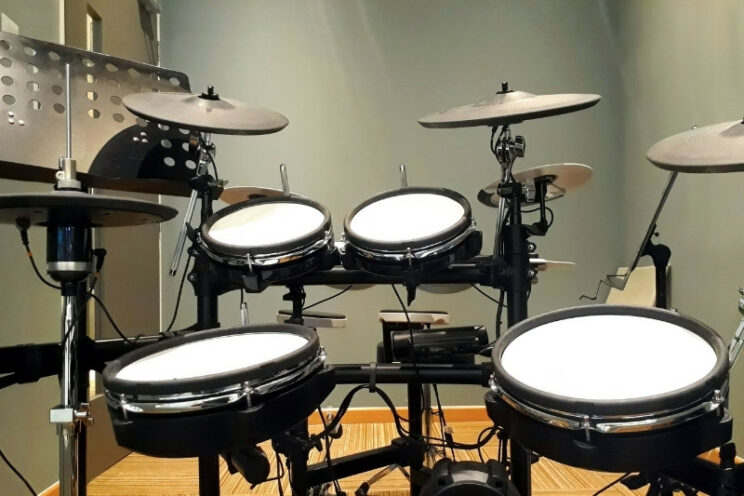
Low Volume
Electronic drum sets are a clear winner when it comes to controlling your volume. Acoustic drums are simply not workable in many different living situations as they may require a lot of soundproofing unless you live in a location that’s pretty far away from neighbors! Even in this case, a loud acoustic drum kit may not go down well with your family.
Metronome and Training Features
Many electronic drum set modules include a metronome, which is essential to improve your timing. Many drum modules also include built-in coaching features, which are great and keep you motivated.
Variety of Sound
Electronic drum sets generally have far more types of sounds than an acoustic drum kit. For example, you can switch between an acoustic-sounding drum kit, a dance-style kit, a percussion kit, or much more.
More expensive electronic drum sets tend to have a lot more kits and internal sounds, and these can be fun to play around with as it makes them very suitable for many different genres and styles.
Easy to Record
Electronic drum sets tend to be very easy to record. Many modules include some sort of onboard recording functionality so you can listen back to your playing. For external recording, you simply only need to connect an audio cable from the back of the electronic drum set to a recorded interface or mixer.
You can also use electronic drum sets for MIDI recording. This is very favorable over acoustic drum sets which require sets of drum mics, and a pretty difficult set-up mixing and recording process.
Transport
Electronic drum sets are far easier to transport. This is their biggest advantage in comparison to the acoustic bass drums. Most electronic drum sets have very small kick pads, whereas acoustic drum kits could have a 22-inch deep drum that you need to transport. The overall weight and bulk of an electronic drum set are generally far lower.
Setup
Electronic drum sets also tend to be quite easy to set up. They often come in a rack and cables and within one connected snake that is easy to find, making it easy to put all of the pieces together.
No Drum Tuning
Drum tuning is quite an art, and it can be difficult to do it properly, even with the use of drum tuners. When you use an electronic drum kit, you do not need to tune any drums. The only purpose of changing the tension of the heads would be for you to reduce the bounce/rebound of the head.
Drawbacks of Electronic Drum Sets
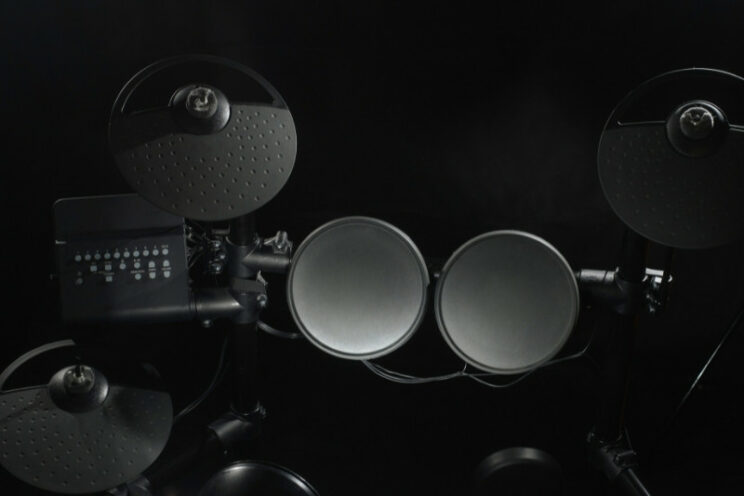
Poor Sensitivity and Triggering
Many of the budget and entry-level electronic drum sets simply still do not have enough sensitivity and triggering. This can mean that playing on one of these sets simply will not feel natural and you won’t get the nuances and feel of playing acoustic drums. However, many of the mid-level and pro electronic drum sets excel in this area, so you just need to choose wisely.
Not Completely Silent
These are considerably quieter than acoustic drums; however, they are never fully silent. Hitting the pads can still cause a bit of noise, which may be heard through walls and floors, particularly if you live in an apartment.
Developing Bad Habits
Drummers can certainly develop bad habits when they are playing on an electronic drum set. Since you can control the volume directly from the module, this means that drummers can often learn to play too soft or too loud without getting a feel for proper dynamics.
Also, many of the drum heads on the market today have a lot of rebound, giving them quite a bouncy feel. Drummers that are accustomed to this may struggle to properly play drum rolls and fills when they go to an acoustic set.
Cymbals
Cymbals are generally the biggest problem area for electronic drums. Even though drum samples have massively improved, cymbals just have such a large depth of sound that it’s very difficult to model these digitally, although technology is quickly improving in this area.
Tactile Response
When you hit an acoustic bass drum you can feel it. This isn’t quite the case with electronic drums. It might sound quite trivial, but it’s one major thing that drummers miss when they go to an electronic drum set. However, some higher-end drums are now using full wooden shells that tackle this problem.
Acoustic Drum Sets
An acoustic drum set consists of a bass drum (with a bass drum pedal), a snare drum, multiple tom drums, a hi-hat (including pedal), a ride cymbal, crash cymbal, and hardware to put everything together.
Of course, many drum sets include additional items. The most common way of extending an acoustic drum set is through extra toms and extra cymbals.
Benefits of Acoustic Drum Sets
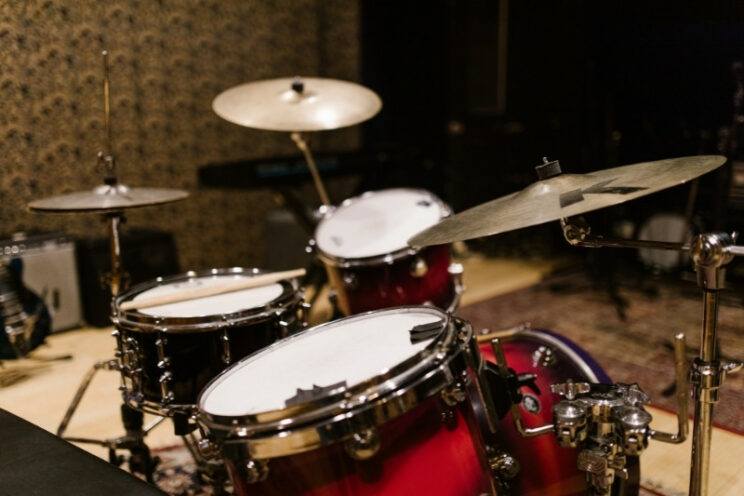
Great Depth of Sound
There are an almost infinite number of ways you can hit a drum or cymbal. Acoustic drum sets offer a far more dynamic range and nuances that are simply not possible with electronic drum sets right now. Things like rim shots, ghost notes, accents, riding the bell of a cymbal, etc. all sound way better on an acoustic set.
Acoustic Genres
An acoustic drum set is the only musically acceptable option when playing live for many different acoustic styles of music, such as rock and jazz. It’s pretty rare to see an electronic drum set being played on stage with these genres. Though, of course, drummers that play in these genres can have a separate electronic drum set for practice.
Great Stage Presence
Acoustic drum sets look fantastic on stage. They have a stage presence that simply cannot be beaten, though sets such as the Roland V-drums Acoustic design are coming somewhat close in terms of stage presence.
Cymbals
Acoustic cymbals are an absolute joy to play and listen to. electronic drum cymbals can sound quite flat in comparison to these.
Drawbacks of Acoustic Drum Sets
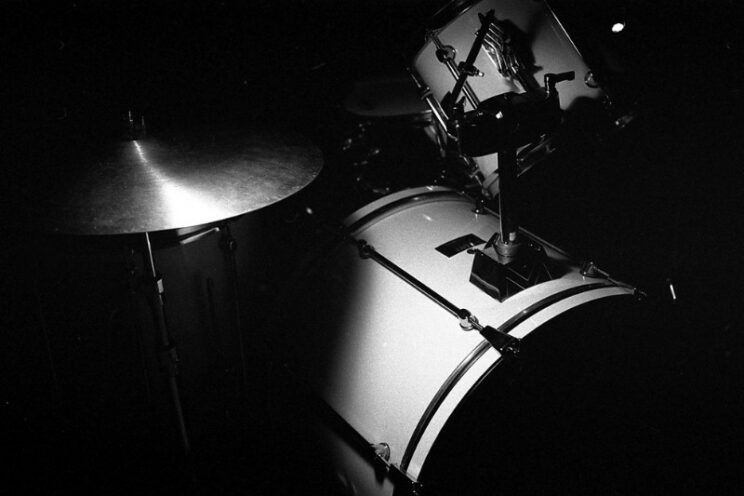
They are Loud
The sound of an acoustic drum set can reverberate through an entire neighborhood! Even when using drum dampening techniques, the sound can still be quite loud through walls and floors. When you dampen the sound, it can make them much less fun to play.
Bulky and Difficult to Transport
Acoustic drum sets also tend to be a lot bulkier, take up a lot more space, and are heavier to transport.
Can be Expensive
Acoustic drums do not have the variety of sound that you would get from an electronic drum set. If you want to get a completely different sounding cymbal or drum, then you will need to buy a new item for the kit. The cost of this can add up quite quickly.
High-end electronic drum sets (such as Roland electronic drum sets) can be very expensive, but the same is very much true when building a pro acoustic kit (where you could pay hundreds of dollars for ONE cymbal!).
Clear side-by-side Comparison
| Electronic Drums | Acoustic Drums | |
| Variety of sound | ✓ | |
| Depth of sound | ✓ | |
| Price | (Varies) | (Varies) |
| Quietness | ✓ | |
| Presence on stage | ✓ | |
| Ease of transport | ✓ | |
| Setup | ✓ | |
| Skills and feel improvement | ✓ | |
| Tactile response | ✓ | |
| Ease of recording | ✓ |
Videos showing the differences
Acoustic Drums
This is a Pearl Session Select, which is a very decent quality kit (Check price on Amazon)
Electronic Drums
This is the excellent Roland TD-50KV, you can find a very similar version of this kit here on amazon.
Check out our guides
Be sure to check out our guide on electronic drums sets:
Also, if you’re new to drums and want to pick up a new acoustic drum set then check out our article on the best drum sets for beginners.
Summary
Acoustic and electronic drum sets are very different instruments. The option you ultimately choose will most likely be based on the amount of noise you can make at home or in your studio.
If you are in a living situation where you cannot make a lot of noise or do not have enough space, then an electronic drum set is probably your only option, unless you can rent a separate rehearsal space for your drum kit. Also, you could check out electronic drum headphones.
If you have a reasonable amount of space where you add some soundproofing techniques to reduce the sound, then an acoustic drum set may be an absolutely amazing option for you.
Of course, your decision shouldn’t just be based on noise constraints, there are many more pros and cons in the debate of acoustic vs electronic drum sets, so it depends on your own preferences. Electronic drum sets certainly offer a greater variety of sound, ease of recording, quicker soundcheck, and ease of transportation.
Alternatively, you don’t have to choose just one. You can also mix both electronic and acoustic items together in the form of hybrid drum kits, as these are becoming ever more popular, particularly on stage for modern music genres.
I hope this has helped you make the decision on whether to go for an acoustic or electronic drum set. If you have any questions, please feel free to leave a comment below.









